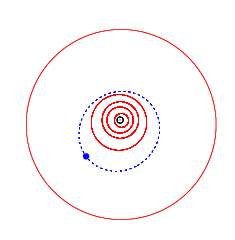 Orbits of Sandage (blue), the
inner planets (red) and
Jupiter (outermost) | |
| Discovery [1] | |
|---|---|
| Discovered by | E. F. Helin |
| Discovery site | Palomar Obs. |
| Discovery date | 9 January 1992 |
| Designations | |
| (9963) Sandage | |
Named after |
Allan Sandage (American astronomer) [2] |
| 1992 AN · 1976 NH 1989 CK6 | |
| main-belt · Phocaea [3] [4] | |
| Orbital characteristics [1] | |
| Epoch 4 September 2017 ( JD 2458000.5) | |
| Uncertainty parameter 0 | |
| Observation arc | 28.13 yr (10,276 days) |
| Aphelion | 2.9982 AU |
| Perihelion | 1.6833 AU |
| 2.3408 AU | |
| Eccentricity | 0.2809 |
| 3.58 yr (1,308 days) | |
| 132.58 ° | |
| 0° 16m 30.72s / day | |
| Inclination | 23.461° |
| 116.97° | |
| 241.14° | |
| Physical characteristics | |
| Dimensions | 5.45 km (calculated)
[3] 6.371±0.174 km [5] [6] |
| 4.6502±0.0008
h
[7] 4.65053±0.00013 h [8] | |
| 0.158±0.025
[5]
[6] 0.23 (assumed) [3] | |
| S [3] | |
| 12.9 [1] · 12.95±0.25 [9] · 13.080±0.002 (R) [7] · 13.53 [3] · 13.6 [5] | |
9963 Sandage, provisional designation 1992 AN, is a stony Phocaea asteroid from the inner regions of the asteroid belt, approximately 6 kilometers in diameter.
It was discovered by American astronomer Eleanor Helin at the Palomar Observatory in California on 9 January 1992, and later named after American astronomer Allan Sandage. [2] [10]
Orbit and classification
Sandage is a stony member of the Phocaea family ( 701), [4] a group of asteroids with similar orbital characteristics. It orbits the Sun in the inner main-belt at a distance of 1.7–3.0 AU once every 3 years and 7 months (1,308 days). Its orbit has an eccentricity of 0.28 and an inclination of 23 ° with respect to the ecliptic. [1] First identified as 1976 NH at Crimea–Nauchnij in 1976, the body's observation arc begins at the German Karl Schwarzschild Observatory in 1989, or 3 years prior to its official discovery observation at Palomar. [10]
Physical characteristics
Rotation period
Two rotational lightcurves of Sandage were obtained from photometric observations at the Palomar Transient Factory and at Texas Tech's Preston Gott Observatory in November 2011 and June 2016, respectively. Lightcurve analysis gave a rotation period of 4.65 hours with a high brightness variation of 0.56 and 0.43 in magnitude, respectively ( U=2/3-). [7] [8]
Diameter and albedo
According to the survey carried out by the NEOWISE mission of NASA's Wide-field Infrared Survey Explorer, Sandage measures 6.4 kilometers in diameter and its surface has an albedo of 0.16, [5] while the Collaborative Asteroid Lightcurve Link assumes an albedo of 0.23 – derived from the family's largest member and namesake, 25 Phocaea – and calculates a diameter of 5.5 kilometers with an absolute magnitude of 13.53. [3]
Naming
This minor planet was named after American astronomer Allan Sandage (1926–2010), a worldwide known expert on stellar astronomy and observational cosmology, who worked at Palomar and Mount Wilson Observatory. [2] Sandage determined the first reasonably accurate values for the Hubble constant and also discovered the first quasar. The official naming citation was published by the Minor Planet Center on 2 September 2001 ( M.P.C. 43381). [11]
References
- ^ a b c d "JPL Small-Body Database Browser: 9963 Sandage (1992 AN)" (2017-03-25 last obs.). Jet Propulsion Laboratory. Retrieved 22 June 2017.
- ^ a b c Schmadel, Lutz D. (2007). "(9963) Sandage". Dictionary of Minor Planet Names – (9963) Sandage. Springer Berlin Heidelberg. p. 715. doi: 10.1007/978-3-540-29925-7_7773. ISBN 978-3-540-00238-3.
- ^ a b c d e f "LCDB Data for (9963) Sandage". Asteroid Lightcurve Database (LCDB). Retrieved 1 August 2016.
- ^ a b "Asteroid 9963 Sandage – Nesvorny HCM Asteroid Families V3.0". Small Bodies Data Ferret. Retrieved 27 October 2019.
- ^ a b c d Mainzer, A.; Grav, T.; Masiero, J.; Hand, E.; Bauer, J.; Tholen, D.; et al. (November 2011). "NEOWISE Studies of Spectrophotometrically Classified Asteroids: Preliminary Results". The Astrophysical Journal. 741 (2): 25. arXiv: 1109.6407. Bibcode: 2011ApJ...741...90M. doi: 10.1088/0004-637X/741/2/90. Retrieved 1 August 2016.
- ^ a b Masiero, Joseph R.; Mainzer, A. K.; Grav, T.; Bauer, J. M.; Cutri, R. M.; Dailey, J.; et al. (November 2011). "Main Belt Asteroids with WISE/NEOWISE. I. Preliminary Albedos and Diameters". The Astrophysical Journal. 741 (2): 20. arXiv: 1109.4096. Bibcode: 2011ApJ...741...68M. doi: 10.1088/0004-637X/741/2/68. Retrieved 4 December 2016.
- ^ a b c Waszczak, Adam; Chang, Chan-Kao; Ofek, Eran O.; Laher, Russ; Masci, Frank; Levitan, David; et al. (September 2015). "Asteroid Light Curves from the Palomar Transient Factory Survey: Rotation Periods and Phase Functions from Sparse Photometry". The Astronomical Journal. 150 (3): 35. arXiv: 1504.04041. Bibcode: 2015AJ....150...75W. doi: 10.1088/0004-6256/150/3/75. Retrieved 1 August 2016.
- ^ a b Clark, Maurice (January 2016). "Asteroid Photometry from the Preston Gott Observatory". The Minor Planet Bulletin. 43 (1): 2–5. Bibcode: 2016MPBu...43....2C. ISSN 1052-8091. Retrieved 1 August 2016.
- ^ Veres, Peter; Jedicke, Robert; Fitzsimmons, Alan; Denneau, Larry; Granvik, Mikael; Bolin, Bryce; et al. (November 2015). "Absolute magnitudes and slope parameters for 250,000 asteroids observed by Pan-STARRS PS1 - Preliminary results". Icarus. 261: 34–47. arXiv: 1506.00762. Bibcode: 2015Icar..261...34V. doi: 10.1016/j.icarus.2015.08.007. Retrieved 1 August 2016.
- ^ a b "9963 Sandage (1992 AN)". Minor Planet Center. Retrieved 1 August 2016.
- ^ "MPC/MPO/MPS Archive". Minor Planet Center. Retrieved 1 August 2016.
External links
- Asteroid Lightcurve Database (LCDB), query form ( info Archived 16 December 2017 at the Wayback Machine)
- Dictionary of Minor Planet Names, Google books
- Asteroids and comets rotation curves, CdR – Observatoire de Genève, Raoul Behrend
- Discovery Circumstances: Numbered Minor Planets (5001)-(10000) – Minor Planet Center
- 9963 Sandage at AstDyS-2, Asteroids—Dynamic Site
- 9963 Sandage at the JPL Small-Body Database